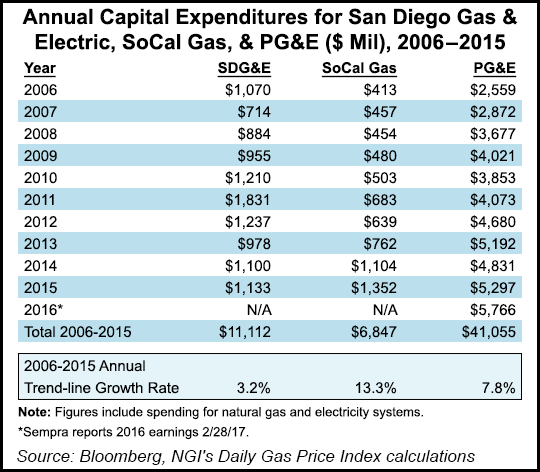Infrastructure | NGI All News Access | NGI The Weekly Gas Market Report
California NatGas Utilities Continue Pouring Billions into Pipeline Upgrades
California’s extensive utility-operated natural gas transmission/distribution pipeline network will continue to receive billion of dollars in enhancements this year, according to the state’s two main operators — Sempra Energy’s Southern California Gas Co. (SoCalGas) and Pacific Gas and Electric Co. (PG&E).

SoCalGas and PG&E have had pipeline safety enhancement programs on a multi-billion-dollar scale since the rupture and explosion of the PG&E transmission pipeline in San Bruno, CA, more than six years ago. State regulators and stepped-up federal pipeline requirements are both in play in the ongoing annual programs.
With the added safety focus on its closed Aliso Canyon underground gas storage facility near Los Angeles, SoCalGas plans to spend about $1.2 billion for improvements to its distribution, transmission and storage systems along with various pipeline safety programs. SoCalGas operates 101,000 miles of gas pipelines.
California regulators last year approved nearly $950 million in increased rates to support PG&E gas storage and transmission pipeline operations. The approval, however, did not include a pending $850 million disallowance associated with the combination utility’s identified shortcomings in handling the San Bruno pipeline failure.
SoCalGas plans to upgrade or replace up to 60 pipeline valves this year to further modernize its pipeline system using remote control valves (RCV) and/or automatic shutoff valves (ASV).
The new valves would allow gas control operators at the Los Angeles-based Sempra Energy gas-only utility to “respond more quickly if gas flow needs to be shut off in an emergency,” a spokesperson said. “The effort is part of the pipeline safety enhancement plan. SoCalGas has replaced or retrofitted more than 100 valve locations since the stepped up pipeline safety effort was launched five years ago.”
SoCalGas deploys five pipeline safety enhancement teams for valve upgrade and retrofit work on an ongoing basis, and is continuing this program through 2022. The teams completed 56 valve upgrade projects last year, the spokesperson said.
The RCVs and ASVs represent the latest technology in the industry, and getting them deployed throughout the utility systems in California has been a big push since the San Bruno incident.
“SoCalGas uses both of these technologies throughout its pipeline system at strategic locations,” the spokesperson said. “As the company continues to upgrade and retrofit valves with RCV and ASV technology, operators will have more flexibility and can respond more quickly if a valve suddenly needs to be closed.”
Last year in granting PG&E rate coverage for its pipeline system safety upgrades, California Public Utilities Commission’s lead member for the case, Carla Peterman, called the utility’s gas operations “a massive aging system” whose total transmission pipelines laid end-to-end would stretch from San Francisco to New York City and back, with pipe left over.
“It carries high volumes of gas near population centers, and the tragic San Bruno explosion is a constant reminder of the need for safe operation of the system,” Peterman said at the time.
The state regulator acknowledged that dozens of stakeholders and consumer advocates involved in PG&E’s rate case argued that its request was too high. “But there was also a broad consensus that the work needs to be completed to improve the overall safety of the PG&E system,” Peterman said.
© 2024 Natural Gas Intelligence. All rights reserved.
ISSN © 1532-1231 | ISSN © 2577-9877 | ISSN © 1532-1266 |
